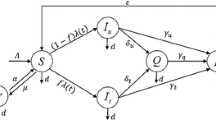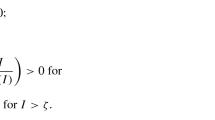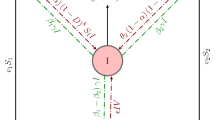Abstract
Vaccination and antiviral treatment are two important prevention and control measures for the spread of influenza. However, the benefit of antiviral use can be compromised if drug-resistant strains arise. In this paper, we develop a mathematical model to explore the impact of vaccination and antiviral treatment on the transmission dynamics of influenza. The model includes both drug-sensitive and resistant strains. Analytical results of the model show that the quantities ℛ SC and ℛ RC , which represent the control reproduction numbers of the sensitive and resistant strains, respectively, provide threshold conditions that determine the competitive outcomes of the two strains. These threshold conditions can be used to gain important insights into the effect of vaccination and treatment on the prevention and control of influenza. Numerical simulations are also conducted to confirm and extend the analytic results. The findings imply that higher levels of treatment may lead to an increase of epidemic size, and the extent to which this occurs depends on other factors such as the rates of vaccination and resistance development. This suggests that antiviral treatment should be implemented appropriately.
Similar content being viewed by others
References
Alexander, M.E., Bowman, C.S., Moghadas, S.M., Summers, R., Gumel, A.B., Sahai, B.M., 2004. A vaccination model for transmission dynamics of influenza. SIAM J. Appl. Dyn. Syst. 3, 503–524.
Alexander, M.E., Bowman, C.S., Feng, Z., Gardam, M., Moghadas, S.M., Röst, G., Wu, J., Yan, P., 2007. Emergence of drug resistance: implications for antiviral control of pandemic influenza. Proc. R. Soc. B 274, 1675–1684.
Alexander, M.E., Moghadas, S.M., Röst, G., Wu, J., 2008. A delay differential model for pandemic influenza with antiviral treatment. Bull. Math. Biol. 70, 382–397.
Arino, J., Mccluskey, C.C., van den Driessche, P., 2003. Global results for an epidemic model with vaccination that exhibits backward bifurcation. SIAM J. Appl. Math. 64, 260–276.
Arino, J., Brauer, F., Driessche, P., van den Watmough, J., Wu, J., 2007. A final size relation for epidemic models. Math. Biosci. Eng. 4, 159–175.
Castillo-Chavez, C., Thieme, H.R., 1995. Asymptotically autonomous epidemic models. In: Arino, O., Kimmel, M. (Eds.), Mathematical Population Dynamics: Analysis of Heterogeneity. Theory of Epidemics. Wuetz 1, pp. 33–50.
Centers for disease control and prevention, 2008. http://www.cdc.gov/flu/flu_vaccine_updates.htm.
Driessche, P., van den Watmough, J., 2002. Reproduction numbers and sub-threshold endemic equilibria for compartment models of disease transmission. Math. Biosci. 180, 29–48.
Earn, D.J.D., Dushoff, J., Levin, S.A., 2002. Ecology and evolution of the flu. Trends Ecol. Evol. 17, 334–340.
Feng, Z., 2007. Final and peak epidemic sizes for SEIR models with quarantine and isolation. Math. Biosci. Eng. 4, 675–686.
Ferguson, N.M., Mallett, S., Jackson, H., Roberts, N., Ward, P., 2003. A population-dynamic model for evaluating the potential spread of drug-resistant influenza virus infections during community-based use of antivirals. J. Antimicrob. Chemother. 51, 977–990.
Fiore, A.E., Shay, D.K., Haber, P., Iskander, J.K., Uyeki, T.M., Mootrey, G., Bresee, J.S., Cox, N.J., 2007. Prevention and control of influenza. http://www.cdc.gov/mmwr/preview/mmwrhtml/rr5606a1.htm.
Kiso, M., Mitamura, K., Sakai-Tagawa, Y., Shiraishi, K., Kawakami, C., et al., 2004. Resistant influenza A viruses in children treated with oseltamivir: Descriptive study. Lancet 364, 759–765.
Lamb, R.A., 1989. Genes and proteins of the influenza virus. In: Krug, R.M., Fraenkel-Conrat, H., Wagner, R.R. (Eds.), In The Influenza Viruses, pp. 1–87. Plenum, New York.
Li, M.Y., Muldowney, J.S., 1995. On R.A. Smith’s autonomous convergence theorem. Rocky Mt. J. Math. 25, 365–379.
Lipsitch, M., Cohen, T., Muray, M., Levin, B.R., 2007. Antiviral resistance and the control of pandemic influenza. PLoS Med. 4, 0111–0120.
Ma, J., Earn, D.J.D., 2006. Generality of the final size formula for an epidemic of a newly invading infectious disease. Bull. Math. Biol. 68, 679–702.
McCaw, J.M., McVernon, J., 2007. Prophylaxis or treatment? Optimal use of an antiviral stockpile during an influenza pandemic. Math. Biosci. 209, 336–360.
McCaw, J.M., Wood, J.G., McCaw, C.T., McVernon, J., 2008. Impact of emerging antiviral drug resistance on influenza containment and spread: Influence of subclinical infection and strategic use of a stockpile containing one or two drugs. PLoS ONE 3, e2362. doi:10.1371/journal.pone.0002362.
Mills, C.E., Robins, J.M., Lipsitich, M., 2004. Transmissibility of 1918 influenza. Nature 432, 904–906.
Mischaikow, K., Smith, H.L., Thieme, H.R., 1995. Asymptotically autonomous semiflows: Chain recurrence and Lyapunov functions. Trans. Am. Math. Soc. 347, 1669–1685.
Nuño, M., Feng, Z., Martcheva, M., Castillo-Chavez, C., 2005. Dynamics of two-strain influenza with isolation and partial cross-immunity. SIAM J. Appl. Math. 65, 964–982.
Regoes, R.R., Bonhoeffer, S., 2006. Emergence of drug-resistant influenza virus: Population dynamical considerations. Science 312, 389–391.
Smith, H.L., 1995. Monotone Dynamical System. An Introduction to the Theory of Competitive and Cooperative Systems. Mathematical Surveys and Monographs, vol. 104. American Mathematical Society, Providence.
Thieme, H.R., 1993. Persistence under relaxed point-dissipativity with an application to an epidemic model. SIAM J. Math. Anal. 24, 407–435.
Wang, W.D., Zhao, X.Q., 2004. An epidemic model in a patchy environment. Math. Biosci. 190, 97–112.
Author information
Authors and Affiliations
Corresponding author
Additional information
Supported by the NSF of China grant 10801074.
Partially supported by NSF grant DMS-0719697.
Rights and permissions
About this article
Cite this article
Qiu, Z., Feng, Z. Transmission Dynamics of an Influenza Model with Vaccination and Antiviral Treatment. Bull. Math. Biol. 72, 1–33 (2010). https://doi.org/10.1007/s11538-009-9435-5
Received:
Accepted:
Published:
Issue Date:
DOI: https://doi.org/10.1007/s11538-009-9435-5




